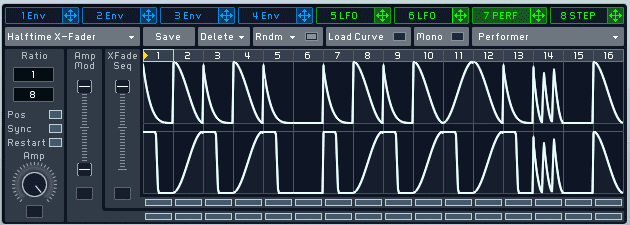
u-he are makers of award-winning software synthesisers and effects including Diva, Repro-1, Zebra2, Hive, Bazille, Presswerk and Satin.
Visit U-he

u-he are makers of award-winning software synthesisers and effects including Diva, Repro-1, Zebra2, Hive, Bazille, Presswerk and Satin.
Visit U-heModulating the Wt-position parameter of an oscillator works in much the same way as modulating any other parameter in Massive. To assign the modulation routing, just drag and drop the crosshairs from one of the modulation sources onto one of the empty boxes below the Wt-position control, then drag up or down on the number that appears in the box to determine the direction and intensity of the modulation.
The results will depend on what kind of modulation source you select. Following this approach, we can use a straightforward envelope to move through the wavetable over the course of a note:
Audio Player…though Massive also has a lot scope for creating unusual envelope curves:
For creating repeating modulations, we can use an LFO:
Audio PlayerAgain, Massive goes a lot further than most synths in terms of LFO flexibility:
Audio PlayerHowever, for full-on modulation mayhem you’ll need to turn to the Performer. This works like a cross between a multi-stage envelope and tempo-synced LFO.
Audio PlayerIf you’re not quite sure where to start, then give the Randomize function a go…
Audio Player…and remember that applying the same Performer modulation to different wavetables can deliver quite different results.
The above examples are deliberately extreme in order to exaggerate the effect and make it clear how the modulation works, but the best results typically come from more subtle applications. Try quick sweeps across a small part of the Wt-position range for filtering-style effects, or slow, smooth LFO-modulation for organically evolving pads.
Finally, bear in mind that Massive offers a further degree of control over the way wavetables are played back in the form of the Intensity parameters, found in the oscillator sections alongside the Wt-position controls.
This works differently depending on the setting chosen in the drop-down menu above.
The default Spectrum option alters the intensity of higher harmonics, whilst Formant transposes parts of the sound spectrum associated with fixed harmonics. The various Bend variants change playback speed with a single waveform cycle. All of these have the effect of changing the overall harmonic balance, whilst maintaining some of the character of the original wavetable.
Massive’s oscillators are incredibly powerful. The great news is that it’s not hard to unlock their potential – you just need to know what they’re capable of doing.
28th September, 2015

u-he are makers of award-winning software synthesisers and effects including Diva, Repro-1, Zebra2, Hive, Bazille, Presswerk and Satin.
Download the demos and try them for yourself at www.u-he.com
09.44 PM
Great article! Biggups!